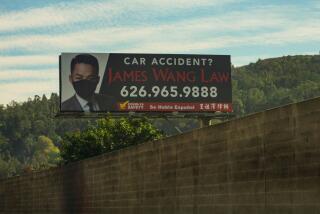Looks Like Sky’s the Limit : Advertising Banner Firm Sees Business Take Off, Fly
- Share via
Lee Hunter squinted anxiously as the single-engine plane skimmed the field at 100 knots, its nose a mere 10 feet above a rope stretched between a pair of poles.
As the airplane crossed the poles, the pilot pulled back sharply on the wheel. The craft abruptly began a steep climb, and a hook attached to its tail snagged the rope.
With that critical first stage of the job accomplished, the pilot headed for his target area, towing a 200-foot-long, 10-foot-high banner behind him.
Another Banner Airlines advertising mission was under way.
On any given day, four or five such flights take off from Chino Airport for 4 1/2-hour flights over sites in the Los Angeles Basin. About half the company’s business is done in the skies over Orange County.
The venture is the creation of Lee Hunter and Terry Ballas, two Anaheim Hills businessmen who have revolutionized the art and science of towing advertising banners.
Expansion in Scope
“To my knowledge, no one is doing it like this,” said Hunter, who until recently put in 16-hour days that combined management, maintenance and flying. Ballas, a real estate developer, devotes his time to other interests, leaving most of the active supervision of the banner business to Hunter.
Although fliers have been towing advertising banners for decades along beaches and over crowded sports stadiums, Hunter and Ballas have greatly expanded the scope of aerial advertising.
In addition to designing banners that are larger, more aerodynamic and easier to read, they have devised a system for precisely targeting the audiences they need to deliver to their clients, and they work closely with advertisers to help them plan an advertising campaign.
For housing developments, for example, Hunter arranges to have the banners towed over large apartment complexes in Orange County in the morning and late afternoon when tenants--a potentially large pool of potential home-buyers--are on the way to or from work.
Banner Airlines was born in 1984 when Hunter tired of the nomadic life style of a drag racer and decided to get into the banner-towing business.
Thought It Would Be Easy
Hunter and Ballas, longtime friends, had taken flying lessons together, and Hunter, at least, decided he wanted to get into a business that would let him continue flying. He said he didn’t know much about towing advertising banners but thought it “was going to be something easy . . . a lay-back thing. I had no idea it would be like this.”
Most of the financing for the business was provided by Ballas. It cost about $50,000 to get started, but the company has made money from the beginning, Hunter said, enabling the partners to pump considerably more than that into expansion.
The original, one-plane company has grown in two years into a six-aircraft concern that employs a dozen full-time people, including a seamstress who stitches together the seemingly endless nylon panels that make up the banners.
It costs about $3,000 to make each of the banners, which will last about 400 hours in the air before the material begins shredding from the combined effects of sun, pollution and stress. Hunter uses expensive oil-based enamel for the letters, and from the ground, the white background appears to be illuminated whether the sun is reflecting off the lettered side of the banner or backlighting it.
A special rudder at the front of the banner cocks it at an angle to the ground, making it easy to read at the company’s normal 1,100-foot altitude.
Attention to Detail
Hunter oversees banner making with an attention to detail that would excite the most placid of accountants. He keeps intricate statistics on the number of calls the banners generate for advertisers each day and carefully charts the areas his pilots fly over. A typical mission involves routes over a dozen locations, with the pilot looping each target three times.
“Most people don’t call on the first pass,” and three passes is enough to get the message across without antagonizing people on the ground with the plane’s buzzing engine, he says. Because Banner guarantees its advertisers a minimum number of responses, Hunter attaches prime significance to just the right amount of exposure. Getting a message over a factory at shift change requires careful timing. “Miss by 10 minutes and you miss your audience,” he said.
No detail of the operation appears to escape Hunter’s scrutiny. After considerable research, for example, he has found positions over many sites that give maximum visibility from the ground. A pilot carrying a message over South Coast Plaza, for example, must line up a mark on his wing with a predetermined point on the ground in order to position the banner for what Hunter has determined to be the easiest reading from the ground.
Flight procedures and just about every other aspect of the business have been committed to manuals written by Hunter. “It’s all here,” he said, flipping through one of the half a dozen manuals in his office. “We’ve upgraded everything.”
Franchising Inquiries
Banner’s success has not escaped the attention of business people in other cities, some of whom have approached Hunter about franchising the operation.
But Hunter says he isn’t ready yet for other locations.
More to Read
Inside the business of entertainment
The Wide Shot brings you news, analysis and insights on everything from streaming wars to production — and what it all means for the future.
You may occasionally receive promotional content from the Los Angeles Times.










